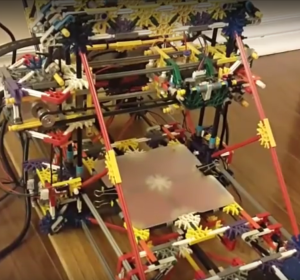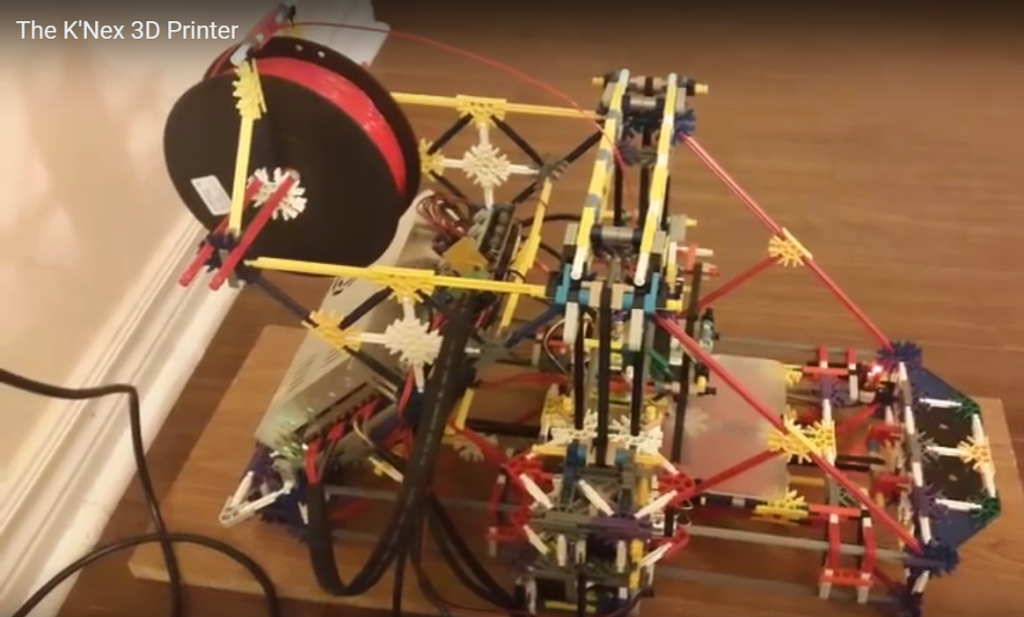 You can create just about anything with a 3D printer – but you can also create a 3D printer out of just about anything. It’s yet another thing that makes this technology unique, and one of the reasons it’s so popular with makers and DIY-ers. You may not be able to print liver tissue or jet engine parts on a 3D printer built out of Legos, but you can print plenty of other things on it (including chocolate, or more Legos). In fact, Legos aren’t the only old childhood toys that can be great raw materials for building working 3D printers. Remember K’Nex? They’re still around, and it turns out they can be used for much more than building models of molecules or lopsided cars.
You can create just about anything with a 3D printer – but you can also create a 3D printer out of just about anything. It’s yet another thing that makes this technology unique, and one of the reasons it’s so popular with makers and DIY-ers. You may not be able to print liver tissue or jet engine parts on a 3D printer built out of Legos, but you can print plenty of other things on it (including chocolate, or more Legos). In fact, Legos aren’t the only old childhood toys that can be great raw materials for building working 3D printers. Remember K’Nex? They’re still around, and it turns out they can be used for much more than building models of molecules or lopsided cars.
Mohammed Al Aryan is a 19-year-old materials engineering student at McMaster University in Ontario, Canada. He first caught the 3D printing bug in his first-year engineering graphics and design course, where he used an Orion Delta 3D printer to print out gears for a project. He became fascinated by the technology and began regularly frequenting his local 3D Hubs until he decided it was time to get his own printer.
“I wanted to learn how they worked inside out, so I decided I would go for a DIY kit,” Al Aryan tells 3DPrint.com. “The Prusa Mendel i3 was what I was thinking of getting since there’s so much support for it already in the RepRap community. I looked through a couple of build tutorials and it was then that I realized that the frame could totally be built out of K’Nex. Doing so would save me some money and would be a fun challenge to take on. Quick searches through Google and YouTube didn’t show any solid examples of working 3D printers made out of K’Nex so I was even more motivated to build it.
We’ve seen a couple of 3D printers constructed from K’Nex, like this K’Nex/Lego hybrid and the Mec’Nex printer, which caught Al Aryan’s eye when he began researching his project. They’ve been very few and far between, however, as well as very experimental, and Al Aryan wanted to design something that would work as reliably as any commercial printer.
“I first tried out a couple of K’Nex designs and prototypes until I got a working model that had stable free moving X,Y and Z axis,” he tells us. “I then made a list of all the electronics I needed to get. I had to make sure the parts I ordered would be compatible with K’Nex. So I didn’t buy everything I needed at once. I would buy a few parts at a time and only when I was able to make it compatible with K’Nex would I buy more parts. This method was cost effective as I wouldn’t be left with a bunch of electronics I didn’t need had the project failed early on.”
The printer took Al Aryan about six months to complete – not bad considering that he had to wait about a month for the delivery of each parts order, while keeping up with his engineering studies at the same time. When his project was finished, he had a working (and colorful!) 3D printer with a build size of 56 x 36 x 31 cm and a print volume of 100 x 140 x 105 mm. The printer runs with Marlin firmware and Pronterface controller software, and Al Aryan also utilizes Slic3r to prepare his print jobs. Right now, he’s only tried printing with PLA at a speed of 40mm/s; he says that he may experiment with different speeds and/or materials in the future, but he wants to fine-tune the current print quality first.
Besides the K’Nex, other supplies Al Aryan used include 5 NEMA 17 stepper motors, a GeeeTech MK8 extruder with a 0.4 mm nozzle, and a 6”x 6” Fleks3D print bed. The total cost for building the printer ended up being a mere $250. So how did he feel about the finished product? Pretty good, as it turns out.
“There were several concerns I initially had, would I be able to properly mount an extruder onto K’Nex? and could K’Nex firmly hold NEMA 17 motors in stable positions? The answer was surprisingly yes to all and that is the beauty in K’Nex, there’s a thousand ways you can arrange these pieces,” Al Aryan concludes. “The trick is in figuring out which arrangement works best…Although it is not a printer I would yet use for professional prints, it’s still something I am really proud I was able to make. I learnt a lot through the process and had a great time working on it.”
You can see the printer in action below. What resourceful technology! Discuss in the 3D K’Nex Printer forum over at 3DPB.com.
Subscribe to Our Email Newsletter
Stay up-to-date on all the latest news from the 3D printing industry and receive information and offers from third party vendors.
Print Services
Upload your 3D Models and get them printed quickly and efficiently.
You May Also Like
3D Printing News Briefs, July 2, 2025: Copper Alloys, Defense Manufacturing, & More
We’re starting off with metals in today’s 3D Printing News Briefs, as Farsoon has unveiled a large-scale AM solution for copper alloys, and Meltio used its wire-laser metal solution to...
BCN3D Files for Bankruptcy Despite Recent Milestones—But Rescue Deal May Be Underway
For the latest updates (as of June 2, 2025), see the end of this article. Spanish 3D printer manufacturer BCN3D has filed for voluntary bankruptcy, according to Crónica Global. Based...
Nikon SLM Solutions Partners with ATI and Bechtel Plant Machinery on 3D Printed Hypersonics
One of the world’s most demanding technical challenges is the creation of maneuverable hypersonic vehicles. The country that does so well will command the ultimate high ground. They will essentially...
HAMR Industries Gets a FormAlloy X5R at Neighborhood 91
The Neighborhood 91 (N91) cluster of additive manufacturing firms in Pennsylvania has acquired a FormAlloy robot arm X5R Directed Energy Deposition (DED) system; specifically HAMR Industries. The X5R can work...



































